Low back pain is a common occurrence regardless of age, but more often in adults. There can be many reasons - from physiological factors to diseases. Sometimes back pain occurs for a while and passes quickly. However, low back pain can be a sign of a serious illness and, in these cases, it is urgent to see a doctor.
Reasons
There are many causes of acute back pain, they are strictly individual for each patient. The most important of these are diseases and changes in the spine, which can respond with irreversible consequences.
Important (most common)
The most common reasons are:
- Osteochondrosis. Awkward movement puts pressure on the roots of the spinal cord nerve trunk. Burning and whining do not stop during the day, if you lift something heavy, there is just pain in the lower back.
- Closed disc. Usually, a hernia is located in the lower back and any sudden movement of the torso brings compression of the nerve roots.
- Rhizokitis. With lumbar rickets, a shooting pain syndrome occurs. Causes heavy lifting or unsuccessful movements. The severe pain restricts the patient's movements so much that he is unable to straighten and remains in the same position he was in when the attack occurred.
- Displacement of the vertebrae. This problem is characterized by shooting pain in the lower back and slightly lower, stiffness of movement. This pathology is accompanied by disorders of urination and bowel function.
- Facet Syndrome. When the faces of the intervertebral discs extend both up and down, the intervertebral foil shrinks. In this case, unpleasant sensations appear that come suddenly and appear more than once a month. Leaning back, the patient experiences back discomfort.
- Epidural abscess. The accumulation of pus in the spinal cord occurs due to infectious diseases of the urinary system. In addition to pain, there is fever, weakness and fever.
These are the causes - the consequences of diseases in the spinal cord.
The lower back can get sick due to the difference in the length of the legs of 2-3 cm. It is difficult for a person to move, a back pain is due to the constant curvature of the spine.
Overload and physical fatigue
In addition to serious diseases, severe lumbar pain in the spine is also due to large overloads and a sharp tilt forward of the trunk. Also, this problem occurs when the effect of temperature on the body is violated. The sources of these pains are:
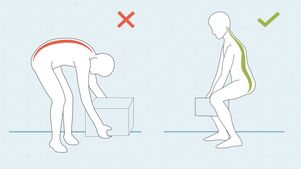
- Stretching muscles. The worsening of muscle strain in the lower back occurs due to physical overload. Muscle compression causes pain and reduces mobility. This problem occurs in athletes and people who work hard.
- Neuralgia. Hypothermia of the back leads to neuralgia - irritation or compression of the nerves. The pathology manifests itself in different ways: sometimes in the form of seizures, accompanied by redness of the affected area, tremor, tissue swelling and severe sweating.
- Myositis. Lumbar pain and discomfort begin at night, as well as with a sudden rise, with a change in weather conditions, after hypothermia and hypertension.
Disorders of internal organs
Sometimes it hurts in the lumbar region due to damage to other organs: heart, liver, kidneys, lungs, gallbladder. On inhalation, the pain syndrome from the lumbar region deviates to all nerve channels. Often the causes of this pathology are:
- Pyelonephritis. It is an infectious inflammation of the kidneys and urinary system. Usually the pain is dull, but the attacks come with chills, weakness, nausea and vomiting, fever.
- Urolithiasis. The problem is revealed as a sudden sharp pain that becomes unbearable with long walks and hard work. The attack is accompanied by nausea, vomiting and blood in the urine.
- Ectopic pregnancy. If there is a ruptured fallopian tube, there is pain in the dark, which emits in the groin, in the rectum. The rupture is accompanied by loss of consciousness and with expulsion of the fallopian tubes a hematoma forms in the peritoneal cavity.
- Pelvioperitonitis. This is a transient inflammatory process of the uterine components. A woman has excruciating pain in the groin and back. In addition to the existing unpleasant sensations, chills, fever and palpitations.
- Tumors of different origins. Metastatic cancer causes painful attacks when pressure is applied to the nerve endings. Often, there are no early signs of the disease.
The difficulties in diagnosing damage to internal organs with severe pain in the lower back. Therefore, you should contact a specialist immediately or call an ambulance. In some cases, the delay can lead to serious health problems and even death.
Lower back pain is felt in almost all pregnant women. This is due to the restructuring of the body and the increase in the load on it. Also, difficult or complicated work can be the cause.
Symptoms of possible diseases
Pain syndrome most often occurs against the background of a nerve sting, osteochondrosis, deformity and degenerative changes in the intervertebral discs, irritation of the nerve roots. Muscle spasms can also cause back discomfort in the lumbar region. Characteristics of the symptoms for various diseases:
- With lumbago, changes begin in the lumbar vertebrae. In the beginning, acute pain can be controlled with medication. However, mobility remains limited.
- With sciatica, the symptoms move lower - to the upper surface of the legs and buttocks. If there is no timely treatment, then the disease becomes a constant companion and can cause other diseases.
- Scoliosis is characterized by skeletal curvature, degenerative changes. The chronic form may be asymptomatic, in other cases, there is bone pain.
- Boring and traumatic pains are typical of diseases of internal organs (mainly the urinary tract and kidneys), benign and malignant tumors.
- With spondylitis, the pain is dull, aching, very weak at first. At the onset of the disease, it begins to ache in the lower back, movements are limited. Gradually, the state of health deteriorates, the inflammation becomes more intense, it becomes difficult to move, even minimal loads are difficult to give.
- In tuberculosis of the spine, in addition to pain, body temperature rises. A person feels tired, weak, weak, appetite worsens. At night, there is heavy sweating, frequent urge to urinate.
Views
The pain can be localized to only one part or "spread" over the abdomen, spine and lower back. The symptoms are acute, in the form of back pain, dullness and pain, they surround. It depends on the disease or the pathological process.
The pain may be intermittent. Usually this is due to physical activity, physiological characteristics, worsening of chronic pathologies. Persistent, chronic pain occurs in the context of various diseases of internal organs, with vascular damage, deformity of the musculoskeletal system.
Sharp
Intense, strong shooting pains lead to limited mobility. During such attacks, a person freezes in one position and cannot move. Even a slight agitation increases the already unbearable pain. This syndrome is called lumbago. Such symptoms may occur after intense massage or hypothermia.
Whine
Pain in pain accompanies chronic diseases, often occurring with vertebral arthritis. Symptoms usually appear at night, immediately after waking up or after sitting for a long time in one place.
Pulling and dumb
These painful sensations can last for a long time, they exhaust the person. Most of the time they are tolerable. Dull and traumatic pains are uncommon for osteochondrosis, more so for spinal pathologies or damage to internal organs.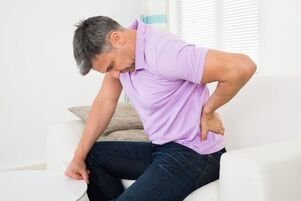 For example, with pyelonephritis, the kidney tissue swells a lot, the capsule stretches, which causes back pain.
For example, with pyelonephritis, the kidney tissue swells a lot, the capsule stretches, which causes back pain.
Pebbles
Symptoms can appear in one place and radiate throughout the peritoneal area, "spreading" along the back. Belt pain affects the entire lower back. Without additional diagnostics, symptoms can be confused with diseases of the spine and joints. However, pain in the belt usually causes pathology of the internal organs.
Pain detection
With ankylosing spondylitis, the symptoms mainly occur in the lower back. Basically, the pain occurs in the morning, it can start even late at night and gradually intensify, giving the lower back. Also, the discomfort in the lower back accompanies diseases of the pelvic organs, trauma to the tail, urological and gynecological pathologies, with the threat of miscarriage, after childbirth.In the upper part, the symptoms appear with kyphosis, trauma, muscular myositis, osteochondrosis, infectious processes or tumors. Also, the cause can be pathologies of the gastrointestinal tract, gynecological, renal and heart diseases, pneumonia, pleurisy, influenza, ARVI.
Pain in the left or right side of the lower back occurs due to disorders of the central nervous system, diseases of the spine and internal organs. The symptoms will appear from the side of the affected area. The appearance of negative sensations immediately on the left and right side accompanies pleurisy, hepatitis, pneumonia, cholecystitis, inflammation of the prostate and in women - the accessories.
Characteristics in women and men
Some types of pain can only occur in women. For example, with gynecological diseases. Adenitis is characterized by the appearance of discomfort in the lower abdomen. In this case, the pain sometimes radiates to the lower back. During pregnancy, the main symptom occurs in the groin area and is transmitted downwards due to increased load on the spine. 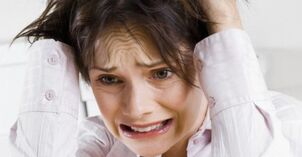 Back pain occurs during childbirth, with the threat of miscarriage, at the end of pregnancy.
Back pain occurs during childbirth, with the threat of miscarriage, at the end of pregnancy.
In men, back pain is more often associated with occupational activities, risks - strenuous exercise, hypothermia, work on a plan. There are certain diseases that cause the appearance of negative symptoms in the lower back. With prostatitis, the pain first appears in the anal area, but may radiate backwards. Epididymitis is characterized by an inflammatory process. Initially, the pain appears in the groin area and then radiates downwards. At the same time, this is accompanied by an increase in temperature and swelling of the scrotum.
First aid
What to do if you have spontaneous back pain? The following steps should be taken immediately:
- Give your back complete rest.
- Take a comfortable position, it is best to lie on a hard surface.
- You can put ice on the lower back, but before that put it on a cheese sheet folded in 3-4 layers. This can only be done if the cause of the pain is not an organ infection.
- Apply a soothing analgesic gel to the affected area.
- Take painkillers.
All of these activities will help you get rid of severe back pain quickly. However, specialist consultation and examination is necessary in order to identify the real cause of this attack and prescribe appropriate treatment.
What not to do
If there is a sudden back pain, doctors advise you not to use ointments and gels immediately. They stimulate blood flow to the toothache, which helps increase swelling and subsequently increase pain. Before a visit to a doctor or the arrival of an ambulance, it is completely and categorically excluded:
- Perform exercises of your choice.
- Wash in sauna or steam bath, do not use rubbish.
- Drinking alcohol for pain relief.
Only a doctor after examination and diagnosis has the right to prescribe treatment for back pain.
What should I do next, which doctor should I see?
You must first see a therapist. He performs an initial examination, prescribes the necessary examinations and, with the results obtained, sends him to a close specialist - an injured person, a surgeon, a neurologist. If the pain is associated with a malignancy, it is necessary to consult an oncologist. When the pathologies of the gastrointestinal tract become the cause - a gastroenterologist, with gynecological diseases - gynecologist, male - urologist or proctologist.
Inspection and inspection
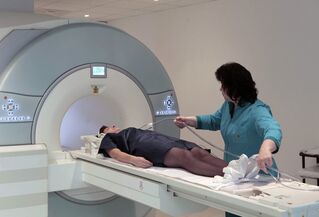
To find out why your lower back hurts, an initial visual examination is performed, followed by palpation. With its help, you can determine the location of the symptom. The patient describes the nature of the pain, the duration of the attacks, after which it may appear (fall, physical activity). In addition, various studies are being carried out:
- Blood test. May show inflammation, presence of infection, tumors.
- Urinalysis. Allows you to rule out kidney pathology. If the resolution is poor, an additional ultrasound is required.
- X-rays. It allows you to detect inflammatory processes, diseases of the spine, injuries, cracks, fractures, nerve stings. Ideally, an x-ray of the bones of the spine and pelvis is done.
- CT. The tomography is more informative than the x-ray, it can show small defects, a three-dimensional image is created. At the same time, all bone structures are visible.
- MRI. Provides the opportunity to explore soft tissues in or near the spine. At the same time, the condition of the spinal cord, nerve roots, ligaments, muscles is checked. Hernias and vascular changes are visible.
Basic treatment
If the back pain is caused by problems with the spine, then complex treatment of the pathology is applied. Includes the following activities:
- organization of a gentle regime for the spine.
- perform manual therapy.
- application of therapeutic massage?
- physiotherapy and reflexology sessions: acupuncture, UHF and more.
- medication: drugs, ointment, exclusion.
- wearing a special corset, if necessary.
- performing rehabilitation exercises.
The main focus is drug therapy, which aims mainly at eliminating the negative symptoms and relieving inflammation. As additional funds, physiotherapy, massage and exercise are prescribed. In difficult cases, surgery may be required.
Drug treatment
Anti-inflammatory drugs are the first choice for back pain. They also relieve pain. Analgesics can be prescribed at the same time. Muscle relaxants are also prescribed. To reduce the degenerative processes in the cartilage, chondroprotectors are prescribed. To relieve pain, drug exclusions are sometimes made on the basis of pain medications.
Topical ointments and gels are grouped into the following types:
- Means based on non-steroidal anti-inflammatory ingredients.
- Combined preparations with anti-inflammatory action and tissue repair.
- Anesthetics and irritants.
- Homeopathic medicines.
- Chondroprotective agents that promote cartilage tissue repair.
- Massage products (cosmetics).
It is important to know that these methods can relieve pain, but they can not cure the underlying cause. For example, damage to internal organs, if lower back pain occurs due to this reason. In this case, you will need to be examined and a specialist will prescribe an effective treatment for the specific pathology.
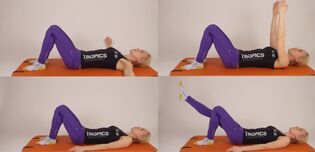
Exercise and massage
Exercise (therapeutic gymnastics) and massage are recommended to strengthen the muscular framework of the back, normalize blood circulation and increase tone. Exercise prevents back and back pain. The exercise therapy complex is selected separately. The massage enhances the effectiveness of the exercises, restores the elasticity and flexibility of the joints. The combination with a bath or sauna is allowed only after medical advice.
Physiotherapy
Physiotherapy methods are prescribed only after relief from acute lower back attacks. Then the procedures help to reduce or prevent the deterioration. Used as physiotherapy:
- mud treatment?
- electrophoresis?
- valnotherapy?
- electrical muscle stimulation?
- phonophoresis (ultrasound);
- paraffin therapy?
- reflexology?
- multiplication therapy.
Procedures help reduce swelling, have an analgesic effect, improve blood circulation, relax muscles and normalize metabolic processes and lymph flow.
Surgical
The absolute indication for surgery is cauda equina syndrome, when urinary and fecal incontinence occurs and numbness occurs in the perineum. Surgery is also necessary if drug treatment is ineffective, the back pain persists for more than six months and begins to radiate to the legs. Surgery is also performed in the presence of a hernia.

Folk remedies
In addition, folk remedies can be used - infusions, decoctions of medicinal herbs. Compresses are made (for example, from chopped onions, fresh burdock leaves, boiled potatoes with horseradish, mustard). Rubbing with eucalyptus and burdock tincture, hot honey, a mixture of cologne, red pepper, iodine and valerian are used. For internal use, vodka tincture with a sword or a decoction of wheat with coriander and milk is recommended.
Expert suggestions
If the pain is felt for at least 3 months, it is considered acute pain. The following tips will help you speed up your recovery from acute back pain and reduce its intensity:
- It is important to give the patient complete rest for 2-3 days. You need to go to bed and take a comfortable position: lie on your side and put a pillow between your knees, or lie on your back and put a pillow under your knees. You can not stand still all day - it is recommended to get out of bed every 2-3 hours and warm up for 10-15 minutes.
- If the pain is not tolerable, analgesics and anti-inflammatory drugs should be taken regularly. Taking them only when the pain increases may not achieve the desired result. Taking a hot shower every 3 hours or applying a warming pad for 10-15 minutes, or even cold, helps - it improves blood circulation, reduces pain and inflammation.
When you feel better, you should gradually return to your normal lifestyle. Staying in bed contributes to muscle atrophy and this exacerbates the disease. You can train your body by walking or walking on the simulator - this is the simplest exercise for low back pain.
If lower back pain is not an independent disease, then it is a consequence of a serious disease that exists in the body. Therefore, you should contact a medical institution immediately to determine the pathology and appropriate treatment.

































